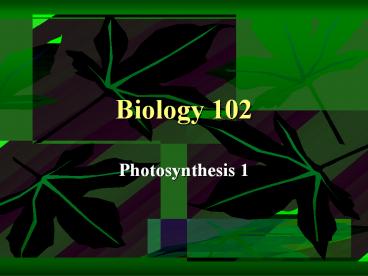Biology 102 - PowerPoint PPT Presentation
Title:
Biology 102
Description:
http://www.spx.org/teachers/socialstudies/lbeaver/documents/APchapter36.ppt – PowerPoint PPT presentation
Number of Views:327
Avg rating:3.0/5.0
Title: Biology 102
1
Biology 102
- Photosynthesis 1
2
Lecture Outline
- Back to the dinosaurs
- What is photosynthesis (and who does it)?
- The light-dependent reactions
3
1. Back to the dinosaurs
4
2. What is photosynthesis?
- Photo light
- Light energy is stored in the energy of chemical
bonds. - Synthesis build
- Organic molecules are built from inorganic
molecules - Carbon-carbon bonds are formed!
- The formulas for photosynthesis and cellular
respiration - Write it down!
5
The relationship between photosynthesis and
cellular respiration
6
Organisms that photosynthesize
- Eukaryotes that photosynthesize
- Plants (all!)
- Some protists
- Marine phytoplankton
- Freshwater and marine algae
- Prokaryotes that photosynthesize
- Example Cyanobacteria
7
Leaves (plants only) and chloroplasts (eukaryotes
only)
- Chloroplasts within mesophyll cells
- Epidermis is thin and transparent (why?)
8
Photosynthesis involves two sets of reactions
- The light-dependent reactions (photo)
- Light energy is captured from the sun and turned
into chemical energy - The energy is temporarily stored within energy
carrier molecules - The light-independent reactions (synthesis)
- Temporarily-stored energy is used to build the
glucose molecule from carbon dioxide and water - Energy is stored in the carbon-carbon bonds!
9
3. The light-dependent reactions
- What is accomplished?
- Light energy is turned into chemical energy
- Overview of what happens
- Light is captured by pigments in the chloroplast
- Electrons of the pigments absorb the energy
- Electrons are transferred between compounds
- ATP and NADPH are both formed
10
What is light?
- Light is one type of energy within the
electromagnetic spectrum - Different wavelengths of light have different
amounts of energy
11
What wavelengths of light do different plant
pigments absorb?
- Note that the color you see is the color that is
not absorbed, but rather reflected!
12
How is the energy of light actually captured?
13
Summary of light-dependent reactions
- Light energy is absorbed by pigments of the
light-harvesting complex and passed to a special
chlorophyll molecule, the reaction center - An electron in the reaction center chlorophyll is
excited and jumps from the chlorophyll molecule
to - An electron acceptor at a higher energy level
14
- The electron is passed between molecules of the
electron transport system - The energy gained (from moving the electron to
lower energy compounds) is used to synthesize ATP
15
- The electron ends up in another chlorophyll
molecule (Photosystem I) - An electron in the reaction center chlorophyll is
excited and jumps from the chlorophyll molecule
to - An electron acceptor at a higher energy level
16
- The electrons are transferred along a second
electron transport chain (along with an H ion)
to a molecule of NADPH
17
Where did the mysterious H come from? What
about the missing electron?
- Its all about the water!
18
Review of light-dependent reactions
19
End result of light-dependent reactions
- Energy from sun was captured and converted to
chemical energy - ATP and NADPH
- Water was split to provide e- and H and
generated oxygen as a bi-product!































